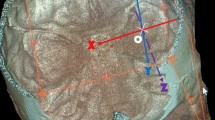Summary
A computer reconstruction method was used to study five normal temporal bones for the three-dimensional anatomy necessary for singular neurectomy. The length of the singular canal was 4.9 ± 0.6 mm. The distal portion of the singular canal courses at a sharp angle (48.2°) to the direction of the transmeatal surgical approach for this operation. The reconstructions indicated that the singular canal can be exposed by introducing a drill through the external auditory meatus at a point 0.71 mm posteroinferior to the posteromedial margin of the round window on the saucerized medial wall of the round window niche. The distance from this site to the distal end-portion of the singular canal averaged 1.47 mm. The point on the drilling course (from the drilling site to the singular canal) closest to the vestibular end of the hook portion of the cochlea was 0.48–1.00 mm from the drilling site. The reconstructions also indicated that the dissection should proceed superomedially, if necessary, after a 1-mm-deep straight dissection along the transmeatal approach. The ampulla of the posterior semicircular canal, cochlear aqueduct and inferior cochlear vein were all found to lie within 2 mm of the drilling point.
Similar content being viewed by others
References
Gacek RR (1974) Transection of the posterior ampullary nerve for the relief of benign paroxysmal positional vertigo. Ann Otol Rhinol Laryngol 83:596–605
Gacek RR (1982) Singular neurectomy update. Ann Otol Rhinol Laryngol 91:469–473
Gacek RR (1984) Cupulolithiasis and posterior ampullary nerve transection. Ann Otol Rhinol Laryngol 93 [Suppl 112]:25–294.
Silverstein H, White DW (1990) Wide surgical exposure for singular neurectomy in the treatment of benign positional vertigo. Laryngoscope 100:701–706
Takagi A, Sando I (1989) Computer-aided three-dimensional reconstruction: a method of measuring temporal bone structures, including the length of the cochlea. Ann Otol Rhinol Laryngol 98:515–522
Takahashi H, Sando I, Takagi A (1989) Computer-aided threedimensional reconstruction and measurement of the round window niche. Laryngoscope 99:505–509
Takahashi H, Takagi A, Sando I (1989) Computer-aided threedimensional reconstruction and measurement of the round window and its membrane. Otolaryngol Head Neck Surg 101: 517–521
Takahashi H, Sando I (1990) Computer-aided 3-D temporal bone anatomy for cochlear implant surgery. Laryngoscope 100: 417–421
Takahashi H, Sando I (1990) Computer-aided 3-D reconstruction and measurement for multiple-electrode cochlear implant. Laryngoscope 100:1319–1322
Author information
Authors and Affiliations
Additional information
Offprint requests to: I. Sando
Rights and permissions
About this article
Cite this article
Takahashi, H., Sando, I. Three-dimensional computer-aided reconstruction and measurement of the temporal bone for singular neurectomy. Eur Arch Otorhinolaryngol 249, 74–78 (1992). https://doi.org/10.1007/BF00186450
Received:
Accepted:
Issue Date:
DOI: https://doi.org/10.1007/BF00186450




